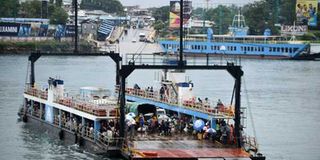Millions ‘lost’ to inflated Kenya Ferry Services tenders

Commuters on board MV Harambee ferry on Likoni Channel. FILE PHOTO | NATION MEDIA GROUP
What you need to know:
- In 2016, President Kenyatta dismissed Managing Director Musa Hassan, Operations Manager Antony Dosho and Chief Engineer George Nyadero.
- The MV Kilindini was operating on a 25-year-old steering system that was not compatible with its new engine, which had run 16,000 hours and badly needed an overhaul.
- Last year, KFS expenditure rose by 15 per cent to Sh1.2 billion from Sh1.1 billion in 2017.
Taxpayers may have lost hundreds of millions of shillings to inflated tenders at the Kenya Ferry Services after President Uhuru Kenyatta set aside Sh2.7 billion to overhaul the agency in 2016.
A confidential memo shows that KFS managers single-sourced supplies, paid monumental legal fees and oversaw a threefold jump in the cost of tenders for ferry overhauls but the proposed repairs that would have made the vessels safer were never done.
“The board felt that these repair costs have increased from 2015/2016, [when] average cost was about Sh30 million per vessel” to an average of about Sh100 million, says the memo sent to the Ministry of Transport by the KFS board on July 31.
BLANK CHEQUE
In 2016, President Kenyatta dismissed Managing Director Musa Hassan, Operations Manager Antony Dosho and Chief Engineer George Nyadero.
Finance Manager Bakari Gowa took over as MD while Moris Kai took over operations, Athmani Washenga became chief engineer and Robert Keng’ara headed finance. Jenifer Sirindi was retained as the head of procurement and supplies.
The new team was to rehabilitate the ferries and improve infrastructure, the agency’s corporate image and financial management, and were handed a blank cheque.
By then the MV Kwale, acquired in 2010, had operated for 29,000 hours against specifications of 8,000 hours and its engines, clutches and generators needed an overhaul.
UNSERVICEABLE ENGINES
The MV Nyayo had run for 14,000 hours and was damaging its manifolds. Even after being dry-docked in 2012 and subsequently recommended for the same in 2014, it continued operations though its open and dangerous prows required fixing.
The MV Kilindini was operating on a 25-year-old steering system that was not compatible with its new engine, which had run 16,000 hours and badly needed an overhaul.
The MV Harambee - bought in 1990 and whose unsecured prows saw the vehicle carrying Mariam Kighenda, 35, and her daughter Amanda Mutheu, 4, slide into the Likoni Channel on September 29, killing them - had been using Caterpillar 3406 series engines that had been phased out by their manufacturers, thus hampering servicing.
Interestingly, the Kenya Maritime Authority, whose role is to regulate sea vessels, only noticed that the Harambee’s prows were faulty after the September 29 ferry tragedy.
“Following an inspection we undertook on Monday September 30, we noticed that some of the prows for the ferries crossing the Likoni Channel are not functional or are not being lifted when the ferries are underway,” Mr George Nyamoko wrote to KFS on October 1. “This is not the first time this is happening and it is unfortunate that nothing was done to remedy this unsafe condition,” he said.
PATCH-UP REPAIRS
Sources at KFS say none of the required engine overhauls proposed in a confidential document titled “Roadmap to Improvement of Ferry Services” presented to the Ministry of Transport was ever done. Instead, all that the ferries got was patch-up repair work at inflated costs.
Even today, the Harambee, Nyayo and Kilindini, which were removed from the international maritime standards body Lloyds Register in 2007 for being unseaworthy, continue to operate, exposing thousands of travellers to danger.
In August an oil tanker entering the Kilindini Harbour came within seconds of colliding with the Kilindini, which was carrying at least 2,000 people and several vehicles.
Last year, KFS expenditure rose by 15 per cent to Sh1.2 billion from Sh1.1 billion in 2017.
Repair costs, for instance, have shot from an average of Sh30 million to Sh100 million and managers hire only one company - Africa Marine - to do the work.
LOW QUALITY SPARES
The memo also says that although the engineering department complained about poor-quality fuel and lubricants only one firm, Gulf, enjoyed preferential business from KFS.
Malika supplied the Kolorama brands of paint, though experts, including the Navy commander, Kenya Ports Authority and KFS engineers said the paints were unfit. The document says the paint lies in stores unused.
The management bought low-quality spares, oils, diesel filters and bearings that were sometimes reused.
While President Kenyatta ordered a second purge in three years, he only kicked out the board, including its chairman Dan Mwazo, who had served for only six months. The terminations were announced in a Kenya Gazette notice dated October 16, 2019.






